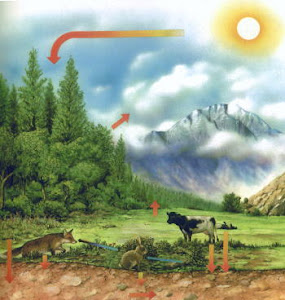Have you ever heard of the water cycle or the earth's energy cycle? Well there is a carbon cycle as well. The carbon cycle is very important to our planet. The carbon cycle, when tampered with by humans, can also be very harmful for our world. On this page we will learn about the carbon cycle and how it works. We will then learn about the importance of the carbon cycle on earth.
There is carbon all over the world, whether in the atmosphere or the oceans. Carbon first has to get into the ocean or atmosphere. Carbon can get into the atmosphere from soil, decomposing animals, waste product, burning sediment from the earth, or events like a volcanic eruption. Some of this carbon goes into the ocean while some of it goes into the atmosphere. Plants on land and phytoplankton in the ocean take in carbon during photosynthesis, turning it into carbohydrates and sugars. Plants and phytoplankton then release oxygen as a byproduct which most living organisms use to breath (including marine life). When land animals or marine life eat plants or phytoplankton they consume the carbon stored from photosynthesis. Organisms then release that carbon when they breath, create waste products, or die and decompose. Some of the carbon goes back into the atmosphere or oceans, some goes into the soil which will later be released into the atmosphere and some forms into rocks, like coal or diamonds. This is an explanation of the carbon cycle.
The carbon cycle is very important to life on earth. The carbon cycle is critical to the food chain. Near the base of the food chain are things like plants and phytoplankton. The next creatures up eat plants and phytoplankton; these animals then get eaten by other organisms and so on. If plants and other organisms who use photosynthesis were not able to get carbon they would die, unable to create food. This would then mean that organisms that eat them would die and so on. Carbon normally tends to collect in certain areas, such as the ocean, forests, and atmosphere, known as sinks. Without the carbon cycle, these areas would collect dangerous levels of carbon, most likely killing living organisms in the area. Thanks to the carbon cycle carbon can flow from areas where it collects into other areas of the earth. The carbon cycle allows organisms to create food and it stops dangerous levels of carbon from collecting in sinks.
The carbon cycle, as we now know, encompasses the whole world and plays a critical role to our earth. Humans are changing the carbon cycle and it could have dangerous affects to life on earth. Trees and plant life are major absorbers of carbon dioxide; this keeps carbon from building in one place. Humans however are cutting down more trees to fulfill our ever growing consumption of natural resources. When we cut down trees and use them for other purposes we release the carbon dioxide they collect back into the atmosphere and oceans. We also get rid of precious storing sources that use the carbon dioxide and convert it into oxygen or store it and release it into the soil. When more carbon dioxide is released into the atmosphere it increases the level of greenhouse gases, increasing the greenhouse effect, trapping heat into the planet, and increasing global warming. To learn more about global warming, visit my next page, "The Evidence Behind Global Warming", located under Links to My Other Pages.
Subscribe to:
Post Comments (Atom)

3 comments:
I would like to use the illustration of the forest carbon cycle. Its wonderful. I will be used in a written lecture on climate change in a online workshop for teachers. I will cite the source of the illustration but can't find it on your blog spot
thanks. This website was all i needed to complete my minor assignment. it covered everyhting i needed to write about. Thanks ;)
Explain to me how CO2, which only accounts for less than one percent of all greenhouse gasses, could cause a worldwide heating effect?
Post a Comment